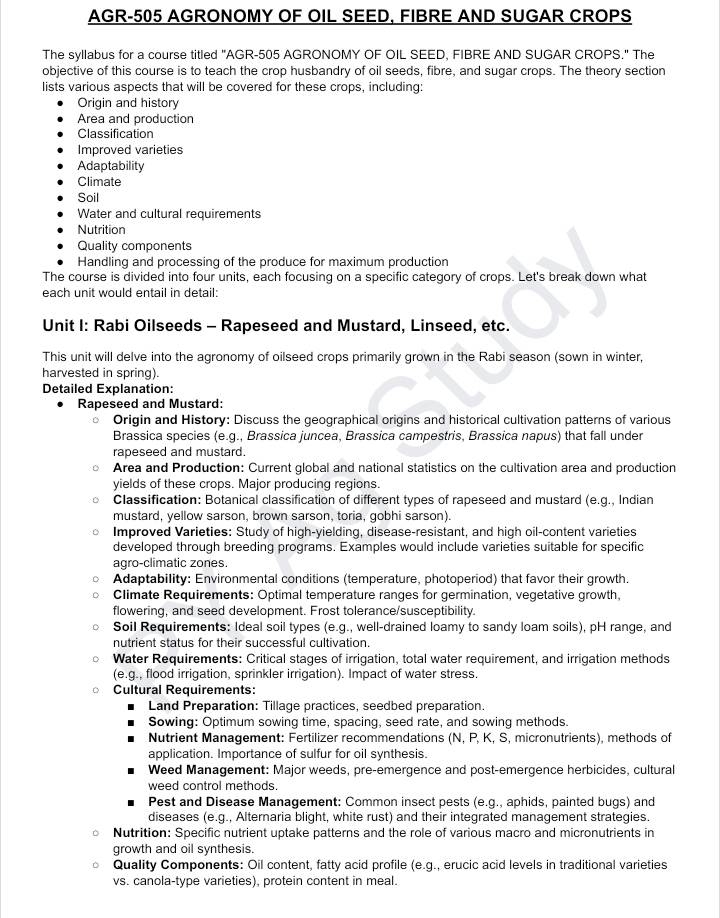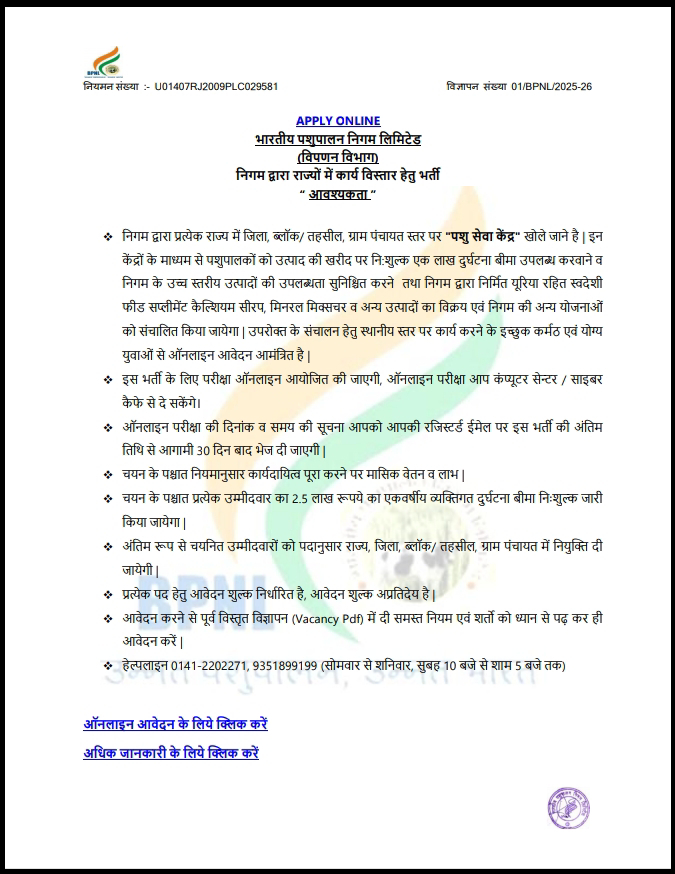Origin and history
Area and production
Classification
Improved varieties
Adaptability
Climate
Soil
Water and cultural requirements
Nutrition
Quality components
Handling and processing of the produce for maximum production
The course is divided into four units, each focusing on a specific category of crops. Let's break down what each unit would entail in detail:
Unit I: Rabi Oilseeds – Rapeseed and Mustard, Linseed, etc.
This unit will delve into the agronomy of oilseed crops primarily grown in the Rabi season (sown in winter, harvested in spring).
Detailed Explanation:
Rapeseed and Mustard:
Origin and History: Discuss the geographical origins and historical cultivation patterns of various Brassica species (e.g., Brassica juncea, Brassica campestris, Brassica napus) that fall under rapeseed and mustard.
Area and Production: Current global and national statistics on the cultivation area and production yields of these crops. Major producing regions.
Classification: Botanical classification of different types of rapeseed and mustard (e.g., Indian mustard, yellow sarson, brown sarson, toria, gobhi sarson).
Improved Varieties: Study of high-yielding, disease-resistant, and high oil-content varieties developed through breeding programs. Examples would include varieties suitable for specific agro-climatic zones.
Adaptability: Environmental conditions (temperature, photoperiod) that favor their growth.
Climate Requirements: Optimal temperature ranges for germination, vegetative growth, flowering, and seed development. Frost tolerance/susceptibility.
Soil Requirements: Ideal soil types (e.g., well-drained loamy to sandy loam soils), pH range, and nutrient status for their successful cultivation.
Water Requirements: Critical stages of irrigation, total water requirement, and irrigation methods (e.g., flood irrigation, sprinkler irrigation). Impact of water stress.
Cultural Requirements:
Land Preparation: Tillage practices, seedbed preparation.
Sowing: Optimum sowing time, spacing, seed rate, and sowing methods.
Nutrient Management: Fertilizer recommendations (N, P, K, S, micronutrients), methods of application. Importance of sulfur for oil synthesis.
Weed Management: Major weeds, pre-emergence and post-emergence herbicides, cultural weed control methods.
Pest and Disease Management: Common insect pests (e.g., aphids, painted bugs) and diseases (e.g., Alternaria blight, white rust) and their integrated management strategies.
Nutrition: Specific nutrient uptake patterns and the role of various macro and micronutrients in growth and oil synthesis.
Quality Components: Oil content, fatty acid profile (e.g., erucic acid levels in traditional varieties vs. canola-type varieties), protein content in meal.
Handling and Processing: Harvesting methods, threshing, drying, storage of seeds, and initial processing steps for oil extraction (e.g., crushing, pressing).
Linseed (Flax):
Similar detailed coverage as rapeseed and mustard, but tailored to linseed's specific characteristics.
Origin and History: Its ancient use for both fiber (flax) and oil.
Area and Production: Global and national linseed production.
Classification: Varieties for oil (linseed) vs. fiber (flax).
Improved Varieties: Varieties optimized for oil yield and quality (e.g., high omega-3 fatty acid content).
Climate, Soil, Water, Cultural Requirements: Specifics for linseed, including its preference for cooler climates and well-drained soils. Unique aspects of its cultivation (e.g., relatively low nutrient requirement compared to other oilseeds).
Nutrition: Focus on nutrients important for seed development and oil quality.
Quality Components: Linolenic acid content, lignin, mucilage.
Handling and Processing: Harvesting for seed, drying, storage, and processing for oil.
Unit II: Kharif Oilseeds – Groundnut, Sesame, Castor, Sunflower, Soybean, etc.
This unit will focus on the agronomy of oilseed crops primarily grown in the Kharif season (sown at the onset of monsoon, harvested after monsoon).
Detailed Explanation:
Groundnut (Peanut):
Origin and History: South American origin, spread globally.
Area and Production: Major global producers (e.g., China, India, USA) and national production.
Classification: Runner, Spanish, Virginia, and Bunch types.
Improved Varieties: High-yielding, disease-resistant, and drought-tolerant varieties.
Adaptability, Climate, Soil, Water Requirements: Specifics like its preference for well-drained sandy loam soils, sensitivity to waterlogging, and critical stages for irrigation (e.g., pegging, pod development).
Cultural Requirements: Unique aspects like earthing up (ridging) to facilitate peg penetration, importance of calcium for pod development, seed treatment for fungal diseases.
Nutrition: Role of calcium, boron, and other nutrients for pod filling. Nitrogen fixation by Rhizobium.
Quality Components: Oil content, protein content, aflatoxin management.
Handling and Processing: Harvesting (digging), drying of pods, decortication, storage, and oil extraction.
Sesame (Til):
Origin and History: One of the oldest oilseed crops.
Area and Production: Global distribution.
Improved Varieties: Non-shattering varieties.
Cultural Requirements: Small seed size, need for fine seedbed, weed competition.
Quality Components: High oil content, unique lignans (sesamin, sesamolin) with antioxidant properties.
Castor:
Origin and History: African origin, industrial applications.
Area and Production: India's dominance in castor production.
Classification: Annual vs. perennial types.
Cultural Requirements: Drought tolerance, wide adaptability, but sensitive to frost. Spacing, pruning.
Quality Components: Ricinoleic acid content in its oil.
Handling and Processing: Harvesting of capsules, drying, decortication, oil extraction (non-edible).
Sunflower:
Origin and History: North American origin, cultivated for oil and confectionary.
Area and Production: Major producing countries.
Improved Varieties: Hybrid varieties, high oleic acid varieties.
Cultural Requirements: Heliotropism, broad adaptability, pest management (birds, head borer).
Quality Components: Oil content, fatty acid profile (oleic and linoleic acid).
Soybean:
Origin and History: East Asian origin, dual-purpose (oil and protein).
Area and Production: Major global producers (USA, Brazil, Argentina).
Improved Varieties: Varieties with high oil and protein content, suitable for different growing seasons.
Cultural Requirements: Nitrogen fixation, sensitivity to waterlogging, pest and disease management (e.g., yellow mosaic virus).
Nutrition: High protein and oil content.
Handling and Processing: Harvesting, drying, storage, and processing for oil and meal.
Unit III: Fibre Crops – Cotton, Jute, Sunnhemp, etc.
This unit will cover the agronomy of crops primarily grown for their fibers.
Detailed Explanation:
Cotton:
Origin and History: Ancient crop with diverse origins, domestication of different Gossypium species.
Area and Production: Global cotton belt, major producers (e.g., India, China, USA).
Classification: Upland cotton (G. hirsutum), Egyptian cotton (G. barbadense), Asiatic cottons (G. arboreum, G. herbaceum).
Improved Varieties: Hybrid varieties, Bt cotton (genetically modified for pest resistance), varieties with improved fiber quality.
Adaptability, Climate, Soil, Water Requirements: Long growing season, warm temperatures, well-drained deep soils. Intensive irrigation requirements, particularly during boll development.
Cultural Requirements:
Land Preparation: Deep plowing.
Sowing: Ridge and furrow system, optimum spacing.
Nutrient Management: High nutrient requirement, particularly nitrogen and potassium.
Weed Management: Significant issue due to wide spacing.
Pest and Disease Management: Major pests like bollworms (pink, spotted, American), whitefly, jassids, and diseases like bacterial blight, wilt. Integrated Pest Management (IPM) strategies.
Growth Regulators: Use of plant growth regulators for boll retention and uniform maturity.
Quality Components: Fiber length, strength, fineness, maturity, ginning outturn.
Handling and Processing: Picking (manual or mechanical), ginning (separation of lint from seed), baling, and transport.
Jute:
Origin and History: South Asian origin, traditional fiber crop.
Area and Production: India and Bangladesh are major producers.
Classification: White jute (Corchorus capsularis) and Tossa jute (Corchorus olitorius).
Improved Varieties: High-yielding varieties.
Adaptability, Climate, Soil, Water Requirements: Hot and humid climate, well-drained alluvial soils, high water requirement, often grown in rainfed conditions.
Cultural Requirements: Broadcast sowing, thinning, retting process.
Quality Components: Fiber strength, luster, fineness.
Handling and Processing: Harvesting, retting (microbial decomposition to separate fibers), stripping, washing, drying, and baling.
Sunnhemp:
Origin and History: Indian origin, used for fiber and green manure.
Area and Production: Cultivated in various tropical and subtropical regions.
Improved Varieties: Varieties for fiber vs. green manure.
Cultural Requirements: Adaptable to various soil types, good for soil health (nitrogen fixation).
Quality Components: Fiber strength.
Handling and Processing: Similar to jute for fiber extraction.
Unit IV: Sugar Crops – Sugar-beet and Sugarcane.
This unit will cover the agronomy of crops cultivated primarily for sugar production.
Detailed Explanation:
Sugar-beet:
Origin and History: European origin, significant source of sugar in temperate regions.
Area and Production: Major producers in Europe and North America.
Improved Varieties: High sugar content varieties, disease-resistant.
Adaptability, Climate, Soil, Water Requirements: Cool season crop, deep loamy soils, relatively high water requirement.
Cultural Requirements:
Land Preparation: Deep plowing for root development.
Sowing: Precision sowing, thinning.
Nutrient Management: High potassium requirement for sugar accumulation.
Weed Management: Critical during early growth stages.
Pest and Disease Management: Major pests (e.g., nematodes) and diseases (e.g., Cercospora leaf spot, root rot).
Nutrition: Focus on nutrients that influence sugar synthesis and storage in the root.
Quality Components: Sugar content (sucrose), purity of juice.
Handling and Processing: Harvesting of roots, transport to sugar mills, washing, slicing, diffusion, crystallization.
Sugarcane:
Origin and History: South Pacific origin, ancient crop, major global sugar source.
Area and Production: Major producers like Brazil, India, China.
Classification: Different species of Saccharum and hybrids.
Improved Varieties: High-yielding, high sugar content, disease-resistant varieties suitable for different agro-climatic zones.
Adaptability, Climate, Soil, Water Requirements: Tropical and subtropical climate, long growing season, wide range of soils but prefers well-drained fertile soils. Very high water requirement, often grown under irrigation.
Cultural Requirements:
Land Preparation: Deep plowing, trenching for planting.
Planting: Setts (stem cuttings) are used for propagation. Various planting methods (e.g., furrow, trench, pit).
Tillering: Promoting tiller development for higher stalk count.
Nutrient Management: High nutrient demand, particularly nitrogen, phosphorus, and potassium. Timing of fertilizer application is crucial.
Weed Management: Critical during early growth due to slow initial growth of sugarcane.
Earthing up: To provide support to growing canes and cover the base.
Detrashing/De-leafing: Removal of old, dry leaves.
Pest and Disease Management: Major pests like borers (shoot borer, stalk borer, top borer), pyrilla, and diseases like red rot, smut, rust. Integrated management.
Nutrition: Role of nutrients in stalk growth and sugar accumulation.
Quality Components: Sugar content (sucrose), purity of juice, fiber content.
Handling and Processing: Harvesting (manual or mechanical), transport to sugar mills, crushing for juice extraction, clarification, evaporation, crystallization, and refining. Ratoon management.
In essence, for each crop listed under these units, the detailed explanation would involve understanding its specific biological characteristics, environmental needs, and the complete cycle of cultivation practices from land preparation to post-harvest handling, all aimed at achieving maximum production and desired quality.








